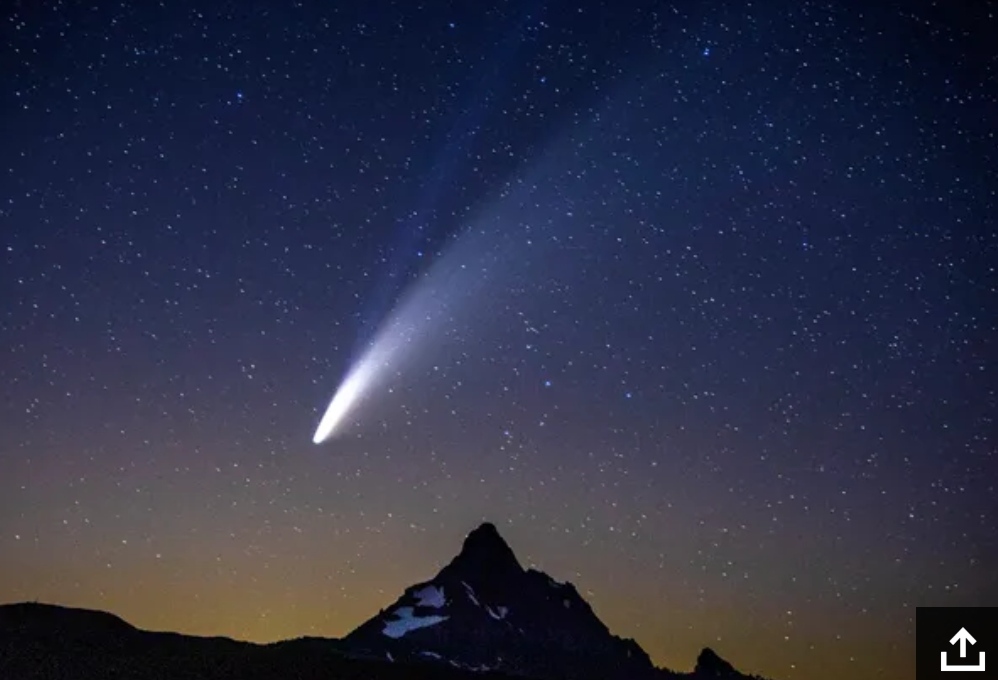How to watch for spectacular Comet Neowise – before it disappears for 6,800 years











 HIGHLIGHTS
HIGHLIGHTS
“The early reviews are in,” Space.com said. “Comet Neowise is a hit.”
Neowise is one of the few comets visible to the unaided eye this century.
The best days to view the comet during the evening will come during the July 14-19 time frame.
It will be hard to miss the amazing sight of a new comet streaking overhead.
Skywatchers are in for a treat over the next few weeks as newly discovered Comet Neowise is paying a visit to the inner solar system for the first time in 6,800 years.
The comet has been getting brighter and brighter in the early morning sky, AccuWeather said, and in the coming days, it will make an appearance in the evening after sunset.
“The early reviews are in,” Space.com said. “Comet Neowise is a hit.”
Neowise is one of the few comets visible to the unaided eye this century, an inner-solar system “intruder” that might become known as the Great Comet of 2020, NASA said.
Although it’s visible with the naked eye, a simple telescope or pair of binoculars can reveal more details, especially when it is seen before twilight in the morning or after twilight in the evening, AccuWeather said.
Far out: First planetary core discovered, astronomers announce
The comet survived its recent closest approach to the sun, and is now headed back toward the outer solar system. Measuring about 3 miles across, Neowise is considered a fairly large comet – providing skywatchers with a spectacular view from Earth, CBS News reports.
It’s actually the brightest comet in 23 years, since Comet Hale-Bopp in 1997, according to NASA. Soon it will be seen in the northwestern sky after sunset, and it will appear to zoom just below the Big Dipper.
To see the comet, start looking about one hour after sunset, when you’ll find it just over the northwest horizon as the last of twilight fades into darkness, according to Sky & Telescope. Look about three fists below the “bowl” of the Big Dipper, which is hanging by its handle high above, and perhaps a little to the right, the website said.
The best days to view the comet during the evening will come during the July 14-19 time frame, Space.com said.
See Comet Neowise before it’s gone for 6,800 years
“Comets are notoriously unpredictable, so it’s impossible to know if this one will remain so easy to spot, but if it does, it should become easier for more people to observe as July goes on,” NASA said.
What killed the dinosaurs?: Study finds asteroid impact, not volcanoes, made the Earth uninhabitable for dinosaurs: ‘Only plausible explanation’
At 64 million miles, the comet will be closest to Earth on July 22, NASA reported.
A NASA space telescope known as NEOWISE first spotted the icy rock, officially called C/2020 F3, on March 27.
The comet will be visible to skywatchers here on Earth through mid-August.
“From its infrared signature, we can tell that it is about 3 miles across, and by combining the infrared data with visible-light images, we can tell that the comet’s nucleus is covered with sooty, dark particles left over from its formation near the birth of our solar system 4.6 billion years ago,” said Joseph Masiero, NEOWISE deputy principal investigator at NASA’s Jet Propulsion Laboratory, in a statement.
Be sure to take a look at the celestial visitor over the next few weeks, if you get the chance: It won’t be back in our neighborhood for thousands of years, as it takes some 6,800 years to complete its journey around the sun, NASA said.




